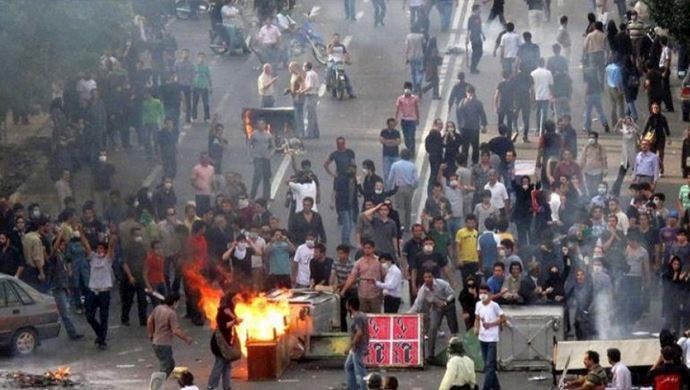
Iran uprising that spread to 180 cities in 14 days with the goal of overthrowing the regime- File Photo
The Washington Times published an op-ed by Ali Safavi this week posited that the recent nationwide uprising in Iran “is unprecedented and exceedingly more audacious than the 2009 and 2017-18 uprisings.”
Safavi, a member of the National Council of Resistance of Iran’s (NCRI) Foreign Affairs Committee, wrote that “Iran’s regime is doomed, desperate and dazed” after the uprising that spread to 176 cities in 11 days with the goal of overthrowing the regime after the mullahs tripled fuel prices overnight. The regime shut down Internet access, killed 450 protesters, wounded 4,000 more, and arrested at least 10,000 people in a failed attempt to quash the rebellion that continues to rage in several cities in Iran.
Safavi laid out his arguments for how the current uprising differs from the 2009 and 2017/2018 uprising in six main points.
Culmination of Smaller Protests
Safavi wrote that the November uprising “is the culmination of thousands of smaller but persistent protests over the past year-and-a-half.” Teachers, students, factory workers, nurses, truck drivers, looted investors, farmers and bazaar merchants have all taken to the streets to protest the regime. Every sector of Iranian society is deeply unhappy with the status quo.
The #Iranian uprising continued in full force on Wednesday for its thirteenth consecutive day as it spread to at least 179 cities across the country.#Iran #IranProtests #MEK #FreeIran @USAdarFarsi pic.twitter.com/SuloBROh46
— MEK Iran (Mujahedin-e Khalq) (@MEK_Iran) November 27, 2019
Solidarity
“Second,” wrote Safavi, “For the first time in the regime’s history, the urban middle class, rural residents, the working class in smaller towns, the ‘army of the unemployed,’ and ethnic and religious minorities (in other words almost all Iranians) invigorated an extraordinary sense of national solidarity and courage against a common enemy. This character is similar to the 1979 uprisings that uprooted the equally corrupt dictatorship of the shah.”
Astounding Pace
Safavi noted that the “astounding pace of the uprising, expanding to over 171 cities in 11 days, speaks to the exceptionally explosive social situation. All it needs is a single spark.”
A Fragile Regime
Safavi wrote that the clerical regime is currently in a weakened state and is terrified of being overthrown. Widespread corruption, a shrinking economy, rampant unemployment, skyrocketing inflation, and the devaluation of the rial have placed the mullahs’ regime in the weakest position of its forty-year reign.
“That is why Tehran shows a zero-tolerance policy in the current uprisings and started the indiscriminate killing of protesters in the first hours and shut down the Internet,” explained Safavi.
Organized Protests
Safavi pointed out that the current protests are more organized than the 2009 and 2017/2018 uprisings. “Equally common but unprecedented are the widespread attacks in almost every city on hundreds of regime institutions, including state-owned banks, religious seminaries, and paramilitary Basij and IRGC bases. These are seen by people as symbols of corruption that must be burnt to the ground just like the regime itself.”
A Deep Bond between the MEK and the Iranian Population
Finally, Safavi emphasized that the Mujahedin-e Khalq (PMOI/MEK) Resistance Units have spent the past 2 ½ years working inside Iran to develop an organized resistance, and their activities have created “a deep bond with the population, making it palpably clear that many years of suppression and demonization failed to drive a wedge between young people and the organization.”
Regime Supreme Leader Ali Khamenei, senior regime officials, and state-run media have acknowledged the role of the MEK in leading the uprising, wrote Safavi, “admitting that the Resistance units are spreading, adapting and implementing increasingly sophisticated tactics to ensure successful anti-regime campaigns.”
In a November 24th op-ed in the Dallas Morning News, Homeira Hesami of the #Iranian-American Community of North Texas argued that international community lacks a complete picture of the Iranian regime’s response to the nationwide protests#IranProtests #Iran #MEK @USAdarFarsi pic.twitter.com/EnWhe7L40b
— MEK Iran (Mujahedin-e Khalq) (@MEK_Iran) November 27, 2019
Ali Shamkhani, the secretary for the regime’s Supreme National Security Council, said in a November 24th press conference, “These people were connected to governments and the Mujahedin-e Khalq (MEK) … I believe 34 MEK members have been arrested so far. A vast network of individuals, operating not under the MEK’s name, but pursuing their line and modus operandi were also identified.”
Safavi argued that the Iranian people are ready for change and that the NCRI, led by Mrs. Maryam Rajavi, offers a democratic alternative to the corrupt regime. The Iranian people need the support of the international community to achieve their goal of a free and democratic Iran.
